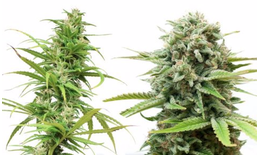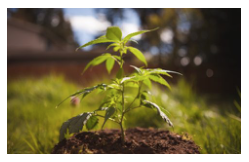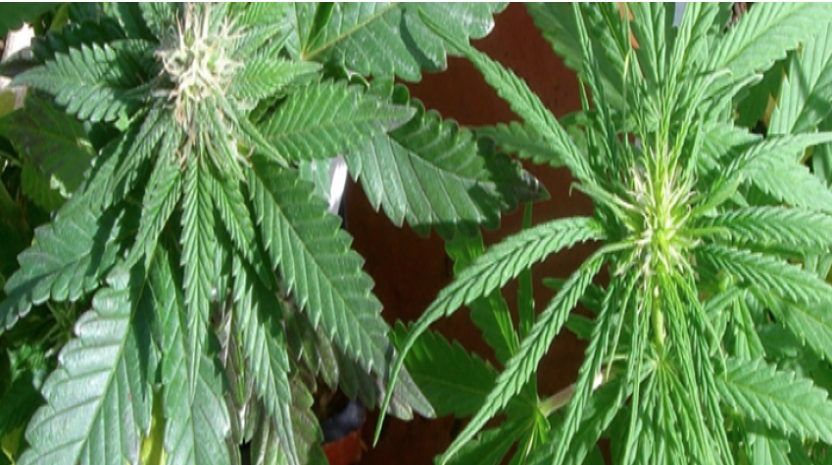Comments420 FILE--When browsing cannabis strains or purchasing cannabis at a shop, you may notice strains are commonly broken up into two distinct groups: indica and sativa. Most consumers have used these two cannabis types as a touchstone for predicting effects:
- Indica strains are believed to be physically sedating, perfect for relaxing with a movie or as a nightcap before bed.
- Sativas tend to provide more invigorating, uplifting cerebral effects that pair well with physical activity, social gatherings, and creative projects.
This belief that indicas and sativas deliver distinct effects is so deeply rooted in mainstream cannabis culture that budtenders typically begin their strain recommendations by asking you which of these three types you prefer.
However, data collected by cannabis researchers suggests these categories aren’t as prescriptive as one might hope—in other words, there’s little evidence to suggest that indicas and sativas exhibit a consistent pattern of chemical profiles that would make one inherently sedating and the other uplifting. We do know that indica and sativa cannabis strains look different and grow differently, but this distinction is primarily useful only to cannabis cultivators.
So how exactly did the words “indica” and “sativa” make it into the vernacular of cannabis consumers worldwide, and to what extent are they meaningful when choosing a strain?
Indica and Sativa: Origin and Evolution of the Terms
The words “indica” and “sativa” were introduced in the 18th century to describe different species of cannabis: Cannabis sativa and Cannabis indica. The term sativa, named by Carl Linneaus, described plants found in Europe and western Eurasia, where it was cultivated for its fiber and seeds. Cannabis indica, named by Jean-Baptiste Lamarck, describes the psychoactive varieties discovered in India, where it was harvested for its seeds, fiber, and hashish production.
 The Cannabis Taxonomy Debate: Where Do Indica and Sativa Classifications Come From?
The Cannabis Taxonomy Debate: Where Do Indica and Sativa Classifications Come From?
Although the cannabis varieties we consume largely stem from Cannabis indica, both terms are used–even if erroneously–to organize the thousands of strains circulating the market today.
Here’s how terms have shifted since their earliest botanical definitions:
- Today, “sativa” refers to tall, narrow-leaf varieties of cannabis, thought to induce energizing effects. However, these narrow-leaf drug (NLD) varieties were originally Cannabis indica ssp. indica.
- “Indica” has come to describe stout, broad-leaf plants, thought to deliver sedating effects. These broad-leaf drug (BLD) varieties are technically Cannabis indica ssp. afghanica.
- What we call “hemp” refers to the industrial, non-intoxicating varieties harvested primarily for fiber, seeds, and CBD. However, this was originally named Cannabis sativa.
Confused? Understandably so. As you can see, with the mass commercialization of cannabis, the taxonomical distinctions between cannabis species and subspecies got turned on its head and calcified. It seems the contemporary use of indica and sativa descriptors is here to stay, but as an informed consumer, it’s important to understand the practical value of these categories—which brings us to the research.
Indica vs. Sativa Effects: What Does the Research Say?
This three-type system we use to predict cannabis effects is no doubt convenient, especially when first entering the vast, overwhelming world of cannabis. With so many strains and products to choose from, where else are we to begin?
“The clinical effects of the cannabis chemovar have nothing to do with whether the plant is tall and sparse vs. short and bushy, or whether the leaflets are narrow or broad.” - Ethan Russo, neurologist and cannabis researcher
The answer is cannabinoids and terpenes, two words you should put in your back pocket if you haven’t already. We’ll get to know these terms shortly.
But first, we asked two prominent cannabis researchers if sativa/indica classification should have any bearing on a consumer’s strain selection. Ethan Russo is a neurologist whose research in cannabis psychopharmacology is respected worldwide, and Jeffrey Raber, Ph.D., is a chemist who founded the first independent testing lab to analyze cannabis terpenes in a commercial capacity, The Werc Shop.
“The way that the sativa and indica labels are utilized in commerce is nonsense,” Russo told Leafly. “The clinical effects of the cannabis chemovar have nothing to do with whether the plant is tall and sparse vs. short and bushy, or whether the leaflets are narrow or broad.”
 Cannabis Anatomy: The Parts of the Plant
Cannabis Anatomy: The Parts of the Plant
Raber agreed, and when asked if budtenders should be guiding consumers with terms like “indica” and “sativa,” he replied, “There is no factual or scientific basis to making these broad sweeping recommendations, and it needs to stop today. What we need to seek to understand better is which standardized cannabis composition is causing which effects, when delivered in which fashions, at which specific dosages, to which types of [consumers].”
What this means is not all sativas will energize you, and not all indicas will sedate you. You may notice a tendency for these so-called sativas to be uplifting or for these indicas to be relaxing, especially when we expect to feel one way or the other. Just note that there’s no hard-and-fast rule and no determinant chemical data that supports a perfect predictive pattern.
If Indica vs. Sativa Isn’t Predictive of Effects, What Is?
The effects of any given cannabis strain depend on a number of different factors, including the product’s chemical profile, your unique biology and tolerance, dose, and consumption method. Understand how these factors change the experience and you’ll have the best chance of finding that perfect strain for you.
Cannabinoids
The cannabis plant is comprised of hundreds of chemical compounds that create a unique harmony of effects, which is primarily led by cannabinoids and terpenes. Cannabinoids like THC and CBD (the two most common) are the main drivers of cannabis’ therapeutic and recreational effects:
- THC (Δ9-tetrahydrocannabinol)makes us feel hungry and high, and relieves symptoms like pain and nausea.
- CBD (cannabidiol)is a non-intoxicating compound known to alleviate anxiety, pain, inflammation, and many other medical ailments.
Cannabis contains over a hundred different types of these cannabinoids, but start by familiarizing yourself with these two first. Instead of choosing a strain based on its indica or sativa classification, consider basing your selection on these three buckets instead:
- THC-dominant strains, such as Gelato 41, are primarily chosen by consumers seeking a potent euphoric experience. These strains are also selected by patients treating pain, depression, anxiety, insomnia, and more. If you tend to feel anxious with THC-dominant strains or dislike other side effects associated with THC, try a strain with higher levels of CBD.
- CBD-dominantstrains contain only small amounts of THC, and are widely used by those highly sensitive to THC or patients needing clear-headed symptom relief.
- Balanced THC/CBDstrains contain balanced levels of THC, offering mild euphoria alongside symptom relief. These tend to be a good choice for novice consumers seeking an introduction to cannabis’ signature high.
It’s worth noting that both indica and sativa strains exhibit these different cannabinoid profiles. “Initially most people thought higher CBD levels caused sedation, and that CBD was more prevalent in indica cultivars, which we now know is most definitely not the case,” Raber told Leafly. “We are more prone to see some CBD in sativa-like cultivars, but there isn’t a systematic rule or relationship in that regard.”
Predicting Cannabis Strain Effects From THC and CBD Levels
 Terpenes
Terpenes
If you’ve ever used aromatherapy to relax or invigorate your mind and body, you understand the basics of terpenes. Terpenes are aromatic compounds commonly produced by plants and fruit. They can be found in lavender flowers, oranges, hops, pepper, and of course, cannabis. Secreted by the same glands that ooze THC and CBD, terpenes are what make cannabis smell like berries, citrus, pine, fuel, etc.
Like essential oils vaporized in a diffuser, cannabis terpenes can make us feel stimulated or sedated, depending on which ones are produced. Pinene, for example, is an alerting terpene while linalool has relaxing properties. There are many types of terpenes in cannabis, and it’s worth familiarizing yourself with at least the most common.
“Terpenes seem to be major players in driving the sedating or energizing effects,” Raber said. “Which terpenes cause which effects is apparently much more complicated than all of us would like, as it seems to [vary based on specific] ones and their relative ratios to each other and the cannabinoids.”
According to Raber, a strain’s indica or sativa morphology does not specifically determine these aromas and effects. However, you may find consistency among individual strains. The strain Tangie, for example, delivers a distinctive citrus aroma, while DJ Short’s Blueberry should never fail to offer the hallmark scent of ripe berry.
If you can, smell the strains you’re considering for purchase. Find the aromas that stand out to you and give them a try. In time, your intuition and knowledge of cannabinoids and terpenes will guide you to your favorite strains and products.
At the Trichome Institute, Students Learn to Predict Cannabis Effects by Aroma
 Biology, Dosing, and Consumption Method
Biology, Dosing, and Consumption Method
Lastly, consider the following questions when choosing the right strain or product for you.
- How much experience do you have with cannabis? If your tolerance is low, consider a low-THC strain in low doses.
- Are you susceptible to anxiety or other side effects of THC? If so, try a strain high in CBD.
- Do you want the effects to last a long time? If you do, consider edibles (starting with a low dose). Conversely, if you seek a short-term experience, use inhalation methods or a tincture.
There are many factors to consider when choosing a strain, but if you truly find that indica strains consistently deliver a positive experience, then by all means, keep ‘em coming. However, if you’re still searching for that ideal strain, these are important details to keep in mind.
The Different Ways to Smoke and Consume Cannabis
What Cannabis Strain Is Right for You?
Before choosing indica or sativa, it is important to consider a third cannabis type: hybrid. Hybrids are thought to fall somewhere in between the indica-sativa spectrum, depending on the traits they inherit from their parent strains.
This may seem overwhelming, especially if you’re a budtender whose job it is to guide consumers to the right product. Ironically, the more you know about cannabis, the more questions seem to arise. But understanding the basic properties of cannabinoids, terpenes, and consumption methods will often answer the most fundamental question of cannabis: What product is right for me?
Here are some helpful beginner resources to get you started:
- Cannabis Strain Recommendations for Beginners and Low-Tolerance Consumers
- Cannabis Product Recommendations for First-Time Consumers
- The Best Cannabis Strains and Products for Every Situation
- How to Find the Best Experience and High for You
For budtenders, be cognizant of the basis of your recommendation, especially for customers treating medical ailments. Educate yourself on the benefits of different cannabinoids and terpenes, and use that knowledge to make a recommendation beyond the oversimplifications and marketing tactics embedded in the sativa/indica distinction.
“In the future, I’d like to see the terms ‘sativa’ and ‘indica’ be abandoned in favor of a system in which the consumer tells the budtender what s/he would like to have in terms of effects from their cannabis selection, and then study the offerings together,” Russo said. “If a buzz is all that is wanted, then high THC with limonene or terpinolene would be desirable. If someone, in contrast, has to work or study and treat their pain, then high CBD with low THC plus some alpha-pinene to reduce short-term memory impairment would be the ticket.”
Cannabis may not be as simple as we’d like, but its diversity and complexity is what makes it such a remarkable plant and tool for consumers of all types.
(Bailey Rahn is an editor at Leafly, specializing in strains and health. She has spent 6+ years researching cannabis products, spreading patients’ stories, and exploring healthy ways of integrating cannabis into daily life.)
-cw













